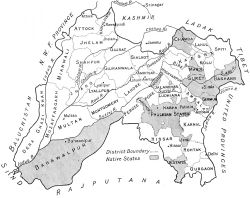1st Sikh War: Difference between revisions
Symorsebrown (talk | contribs) Add external link. Remove dead library link |
Symorsebrown (talk | contribs) m Add note to field force |
||
| Line 10: | Line 10: | ||
== The Army of the Sutlej == | == The Army of the Sutlej == | ||
'''Units at the first engagement at Moodkee. See other actions for forces on those occasions.'''<br> | |||
''Commanding in Chief: [http://en.wikipedia.org/wiki/Hugh_Gough,_1st_Viscount_Gough Maj-Gen Sir Hugh Gough]''<br> | ''Commanding in Chief: [http://en.wikipedia.org/wiki/Hugh_Gough,_1st_Viscount_Gough Maj-Gen Sir Hugh Gough]''<br> | ||
''Second in Command: [http://en.wikipedia.org/wiki/Henry_Hardinge,_1st_Viscount_Hardinge Maj-Gen Sir Henry Hardinge], Governor General of Bengal''<br> | ''Second in Command: [http://en.wikipedia.org/wiki/Henry_Hardinge,_1st_Viscount_Hardinge Maj-Gen Sir Henry Hardinge], Governor General of Bengal''<br> | ||
Revision as of 17:27, 14 November 2009
| 1st Sikh War | |
|---|---|
| 1845-46 | |
| Chronological list of Wars and Campaigns | |

| |
| Location: Punjab | |
| Combatants: | |
| East India Company | Sikh Empire |
| Result: British victory | |
| Medals: Sutlej Medal Clasps: Moodkee, Ferozeshuhur, Aliwal, Sobraon | |
| Links: | |
| Category: 1st Sikh War | |

|
See our interactive map of 1st Sikh War locations and routes on Google Maps | |
|---|---|---|
The 1st Sikh War, also called the First Anglo-Sikh War or the Sutlej Campaign.
Summary
After the death of Ranjit Singh in 1839, there was a period of internal strife as the succession to Sikh leadership was contested. Sikh forces were increased as were those of the British in the newly acquired territory adjoining the Punjab. Tension built up with demand and counter-demand until the British moved forces toward Firozpur and the Sikh Khalsa crossed the Sutlej. Four major actions were fought and all were won by the British. Large areas of territory were ceded to the British and a British Resident placed in Lahore effectively controlled the Sikh government.
Actions
See Category:1st Sikh War for an alphabetical list.
The Army of the Sutlej
Units at the first engagement at Moodkee. See other actions for forces on those occasions.
Commanding in Chief: Maj-Gen Sir Hugh Gough
Second in Command: Maj-Gen Sir Henry Hardinge, Governor General of Bengal
Cavalry Division
Major General Sir Joseph Thackwell
- Brigadier Mactier’s Brigade
- 9th Bengal Irregular Horse
- One wing of 4th Bengal Light Cavalry
- Brigadier Gough’s Brigade
- Brigadier White’s Brigade
1st Infantry Division
Maj-Gen Sir Harry Smith
- 1st Brigade: Brigadier Bolton
- 2nd Brigade: Colonel Wheeler
2nd Infantry Division
Major General Gilbert
- 1st Brigade
- 2nd Brigade
3rd Infantry Division
Major General McCaskill
- 1st Brigade
Artillery
- 5 troops of Horse Artillery
- 2 batteries of light Field Artillery
External Links

|
The FIBIS Google Books Library has books tagged: 1st Sikh War Sikhs | |
|---|---|---|
1st Sikh War 1845-46 Wikipedia
1st Anglo-Sikh War Sikhiwiki
Journal of the Sutlej Campaign Google Books
Despatches of the Generals Google Books
Map of the Punjab Wikipedia
Historical books online
- The history of the Sikhs: containing the lives of the Gooroos; the history of the independent Sirdars, or Missuls, and the life of the great founder of the Sikh monarchy, Maharajah Runjeet Singh by William Lewis M’Gregor MD Surgeon 1st European Light Infantry 1846 Google Books Volume 1; Volume 2 contains details of the battles.
- Ten years in India, in the 16th Queen's Lancers by WJD Gould (1880) [Archive.org]